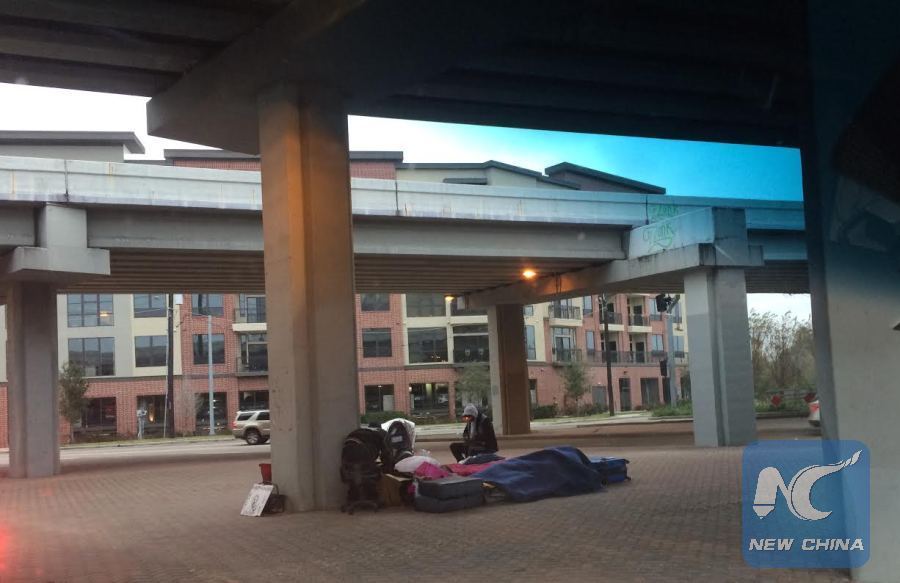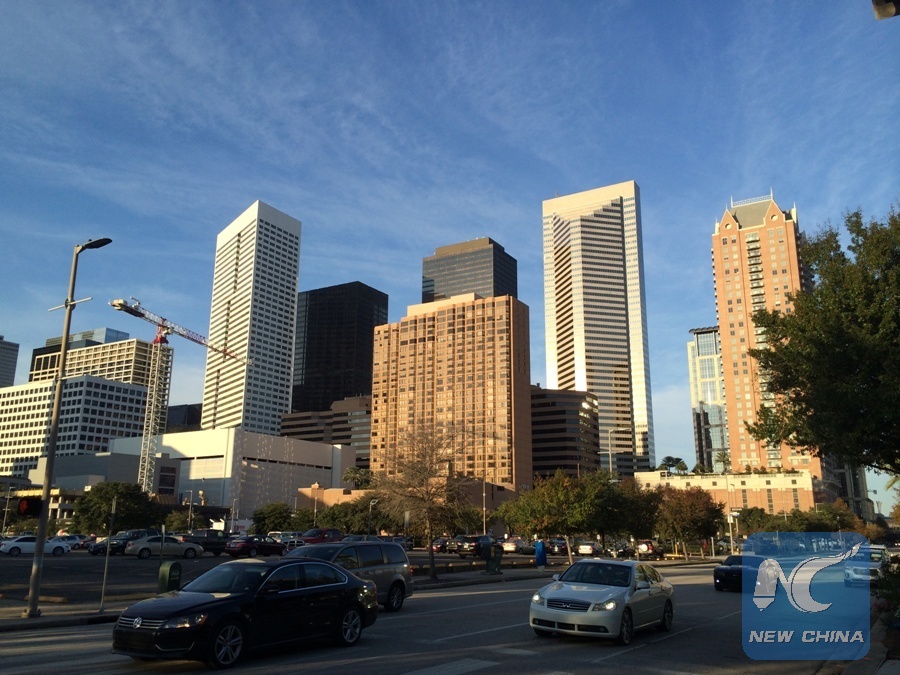
Homeless people under flyovers in downtown Houston. (Xinhua/Zhang Yongxing)
HOUSTON, Feb. 18 (Xinhua) -- Texans Carlos Santiago and Mary New, who both went from local schools to careers to partial retirement in Houston may as well live on separate planets when it comes to their lifestyles and financial realities.
While both remain residents of -- and plan to end their days in -- the nation's fourth largest city, Santiago and New are on opposite sides of a wide income gap. Texas is home to more than 27 million people, including nearly 50 billionaires and more than 4.5 million people living in poverty.
"Texas is among the states with the highest income inequality," says a December 2016 article posted on the Center on Budget and Policy Priorities. "Texas ranks 10th in the country, with its richest residents - the 5 percent of households - having average incomes 15 times as large as the bottom 20 percent of households and five times as large as the middle 20 percent of households."
While Santiago and New are neither billionaires nor ranked at poverty level, Santiago's once-steady work as a public relations consultant and photographer does not allow him to even maintain his high-crime north neighborhood apartment.
"I'm going to move in with my sister in Conroe (north of Houston). Temporarily, I hope," said 43-year-old Santiago, adding that his sister had health issues, and asked him to come and help out.
Santiago's general field of communications and information wasn't even listed in the 2016 list of Texas Growth Opportunity jobs by the Texas Workforce Commission (TWC). Published by the TWC in 2015, projections for that industry anticipate a growth of 1,000 U.S. dollars, or average wages of 39,000 to 49,000 U.S. dollars annually, from 2014 to 2024. The statistics, however, do not include telecommunications, which is expected to grow from 79,000 to 89,000 U.S. dollars during the same 10-year period.
Santiago eats on a frugal diet at home, sometimes augmented by free bread, butter and jam set out for patrons after shelling out for a cup of coffee at some chain restaurants.

A street shot of downtown Houston. (Xinhua/Zhang Yongxing)
At the same time, New, a retired teacher, and her husband of 35 years, a project manager for one of the country's top five oil and gas engineering companies, treat themselves to one of their favorite restaurants almost every night.
"I might cook a meal every two weeks," said New, 68. "Both our parents left us a significant nest egg and they were cautious about their money. Between my retirement and my husband's salary, I guess we have, in excess of or close to, 250,000 (U.S. dollars annually). We have stocks and bonds. I guess you'd say we're reasonably affluent."
The News enjoy traveling, especially on cruises, all over the world, and live in a paid-off, 3,700-square-foot house so filled with furniture, mementos, three dogs and three cats that she described it as qualifying for a reality TV show, "Hoarders: Buried Alive."
New's husband recently bought a new truck, but New said she is still driving her high-mileage car.
"He likes to shop for gadgets we don't need, and I give to quite a few animal rescue groups," New said.
She said a lot of their money was spent on medical care, and they sent their daughter to an expensive, private university, and gave her an expensive wedding.
"We have two little grandchildren and I went crazy for (buying) their Christmas stuff, and I set aside money every month in an account for them, just as we did for our daughter and just as my mother did for me," New said.
As her husband approaches retirement, which will almost halve their income depending on how their stock investments fare, New is glad neither of them owes any credit card or personal debt.
New will still receive her own money from government-sponsored Social Security and from a pension from her 35-year teaching career.
Teaching and administering schools in Texas employed about 800,000 people in the 2014 workforce. According to the TWC projection, there will be more than one million teachers in the state by 2024 with an average weekly wage of 784 U.S. dollars.
New's husband will receive about 100,000 U.S. dollars in benefits from his investment and retirement planning from the oil and gas industry after his retirement next year.
"Instead of going out to eat every night, we may have to eat at home every two or three nights," New said. "But I don't foresee any big changes."
Santiago, who has augmented his dwindling earnings with some freelance work and money saved from a small inheritance left to he and his sister by their father, is also fiscally careful, paying cash or debit for necessities only if and when he has enough money in his fluctuating bank account.
Texas's experience in income growth inequality has been around for about three and a half decades, according to the Center on Budget and Policy Priority's December study. That's just slightly longer than U.S. income gains have gone largely to the richest households, while many middle and lower-income Americans have increased work production while not seeing advantages in salary or benefits as part of the nation's growing prosperity.
Economist Mark Frank, professor and chair of the Department of Economics and International Business at Sam Houston State University, said that income leveled during the 2008 recession, but the wealthiest Texans quickly recovered their losses through bank bailouts and other monetary manipulations.
"In a couple of years, we returned to the trend where the wealthiest 1 percent -- even the 0.1 percent of the upper scale -- showed significant increases," Frank said in an exclusive interview with Xinhua. "Part of that has been growth from heavy recruitment of top income earners from other states."
Texas is a really diverse state in terms of poverty and wealth, Frank said, with a huge pocket of poverty in the South Texas Valley, which is largely a Hispanic, or predominately Spanish-speaking population.
"South Texas is one of the highest poverty areas in all of the United States," Frank said. "And this area grew poorer at the same time as the growth was re-emerging in the wealth of the top income level."
Though born and raised in central Texas, Santiago is of Hispanic heritage, though he was born into an upper-middle-income family. But more than two decades ago, he chose photography over his higher-paying banking job, a choice he doesn't regret despite the disparity in wealth potential and now-periodic income that doesn't often allow for luxuries.
When he has cash beyond covering life's basics, he said, he first pays his few bills and maintenance of his used, older model car. Then he ventures to state national parks with a small tent he can use to avoid hotel costs and shoot photos he plans, sometimes successfully, to sell to Texas travel and tourism publications.
Since 1990, the job growth rate in Texas has outperformed the country's by more than two to one as income inequality has been rising steadily to the point that the state now ranks fifth for income inequality, Frank said.
At the same time, he said, the children of the affluent are likely to stay near the top percentage of income earners, while the Equality of Opportunity Project -- a Dallas study last summer -- showed that only 6.4 percent of low-income-family children in the bottom fifth of income make it to the top-fifth tier.
Manufacturing jobs moving abroad, elimination of low-skilled jobs and productivity and income bump for other workers resulting from new technologies, and investment markets and tax cuts have benefited the wealthy. At the same time, the price tag for college education -- mandatory for most high-end jobs -- has continued to skyrocket, making it increasingly unavailable to the poor and middle classes..
"The top 1 percent of America's income earners have more than doubled their share of the nation's income since the middle of the 20th century. American top 1 percent incomes peaked in the late 1920s, right before the onset of the Great Depression." wrote Emmanuel Saez, Center for Equitable Growth in June 2015.
Santiago said he isn't waiting around for the next great depression or economic revolution, whatever comes next.
"I'm going to keep shooting pictures, writing, developing an Internet blog, bagging groceries if I have to," he said. "Then I'll take my money and move somewhere I can grow enough to survive. Most likely, on the side of some mountain in South America where views are beautiful and living is cheap."

